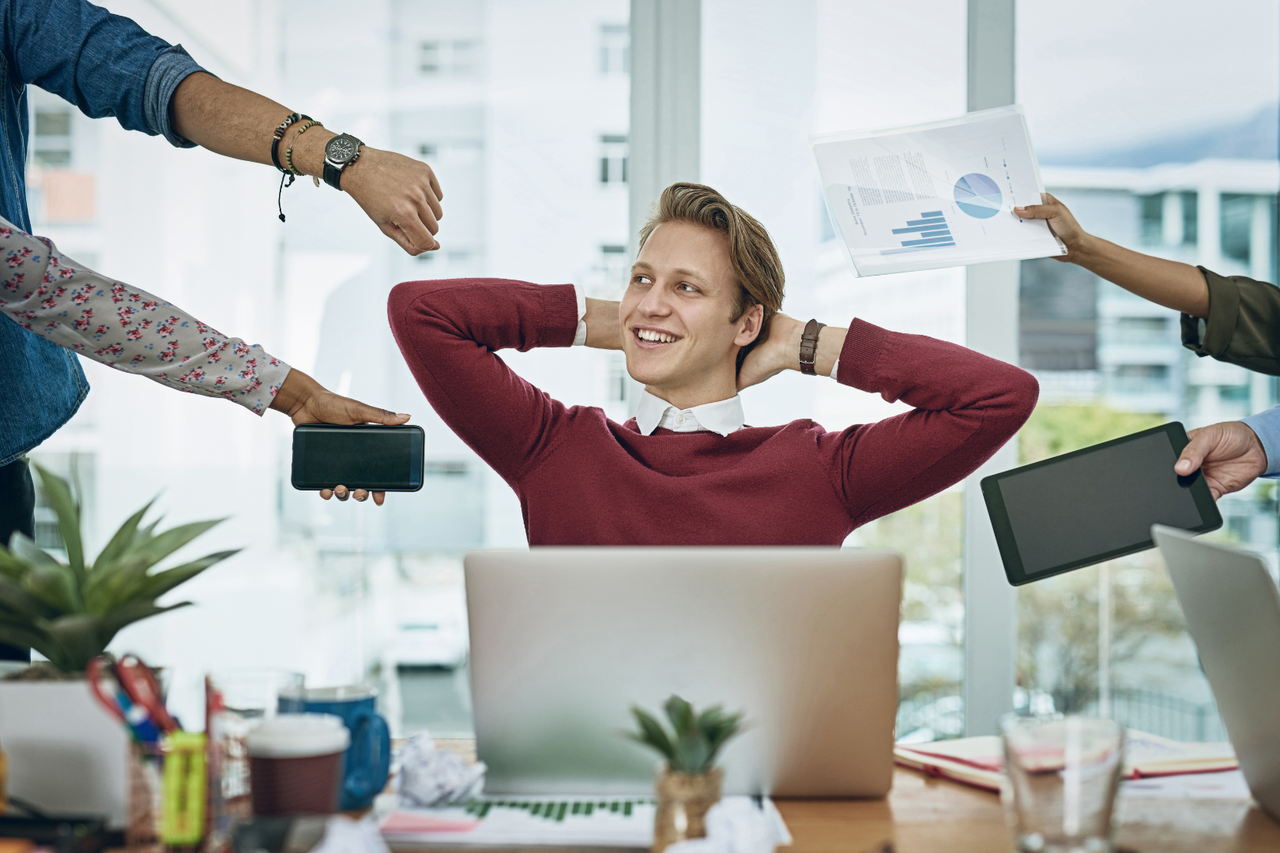Did you know that 52% of workers in Canada and the US reported significant stress throughout the day yesterday? In Europe, this figure is 39%. Sadly, stress levels are notably higher among young workers and those in remote or hybrid work environments. These statistics are concerning and call for action. Stress not only affects the individuals experiencing it but also their colleagues, who may face additional burdens when stressed out team members can no longer take their part of the workload.
On top of this, stress also has a substantial financial impact costing US organizations an estimated $300 billion alone.
Preventing stress is therefore crucial. This guide provides essential insights into the nature of stress, offers a framework for engaging in meaningful discussions about stress with your colleagues, and shares practical tips and strategies for both teams and individuals to improve well-being and prevent stress from occurring.
One very important aspect to mention before we dig deeper into this topic, is that stress will occur, as long as there are structural and organizational stressors at play. While individual and team efforts can alleviate stress to a certain extent, systemic barriers may hinder overall well-being. A common structural challenge that often leads to stress is the imbalance between the time allocated to clients and their needs. Regardless of personal coping strategies, this imbalance will induce stress simply because of the imbalanced demands. Furthermore, this imbalance can contribute to feelings of diminished influence and control, exacerbating the stress response.
Therefore, when you have dialogues about stress and its prevention at work, it's crucial to have an open and sincere talk about the structures in your workplace that contribute to and hinder you in thriving. Individualizing stress is not fair; stress is influenced by a broader range of factors.
That said, let’s dig in!
1. Understand the Definition of Stress
Firstly, what exactly is stress? Stress is the body's reaction when internal or external pressures, known as stressors, surpass our ability to cope, both physically and mentally. These stressors trigger physical and mental responses that can be overwhelming.
Stress manifests in two primary forms: acute and chronic.
Acute stress occurs when the body experiences a sudden shock, necessitating an immediate fight, flight, or freeze response to prevent harm. This type of stress is intensely felt; for instance, your body tenses up, and a surge of stress hormones such as cortisol, epinephrine, and norepinephrine sharpens your alertness, tightens your muscles, and elevates your blood pressure, focusing your senses sharply. Acute stress occurs for instance when you narrowly avoid a car accident or when a loud noise suddenly appears. These moments of shock and acute stress are very “felt” and visible.
Chronic stress, on the other hand, develops gradually. The continuous exposure to stressors may not initially trigger noticeable reactions because the body becomes habituated to the strain. This adaptation is dangerous, as it may lead to burnout if you over time ignore the subtle, accumulating symptoms. Chronic stress can lead to serious health problems including high blood pressure, heart disease, anxiety disorders, and gastrointestinal problems. Therefore, it is crucial that you get to know the symptoms of stress so that you can do something about them in due time!
2. Discover Stress Symptoms in due time
It is important that you get to know the symptoms of stress, because how else will you know what to look out for in terms of recognising the signs of stress in yourself and your colleagues?
Here is a list of some of the most common stress symptoms:
Behavior
- Less or no ability to perform as well as usual
- Withdrawing from others - or over engaging
- Indecisiveness– can’t finish/end things and can´t take (the right) decisions
- Conflicts with others
- Single-focused life (work)
- Substance-abuse
Cognitive level
- Issues with concentrating and keeping the overview
- Impaired short term memory
- Confusion
- Selective attention on (stupid) details
- Find it hard to learn new things
- Lack of dedication and motivation
Physical
- Headache
- Dryness in throat
- Tensions
- Heightened heart-beat
- Dizziness
- Problems with digestion - upset stomach - irritable bowel syndrome
- Sleeplessness/insomnia
Mood and feelings
- Moodiness / Mood swings / Emotional roller-coster feelings
- Irritability
- Impatient
- Restless
- Anger / aggression / cynicism
- Anxiety / guilt - feeling “behind”
- Feeling down / sad / depressed
However, a word of caution is necessary. Focusing excessively on symptoms can inadvertently amplify them. Remember: What you shed light on grows!
Monitoring signs of stress so that you can intervene if you are on the slippery slope towards stress makes sense. But equally important is it to deliberately notice and acknowledge the positive aspects of your life and work. Regularly recording what you’re grateful for and what brings you joy and energy, for instance in a daily journal, can significantly enhance your level of well-being and happiness, both at work and at home. We therefore highly recommend that you deliberately help yourself and your colleagues shed light on (and celebrate) your successes, accomplishments and things that work well and bring you joy!
3. Know the Difference Between Stress and Busyness
It is important to know the difference between being “just” busy, later on strained and eventually being stressed and maybe even burned out. It is important because the help you yourself, your colleagues or your employees need depends on which condition is at play.
The illustration below provides a guide to distinguish between being calm, busy, strained, stressed, and burned out. It also outlines appropriate interventions for each condition. This visual aid can help not only leaders, aiming to tailor their approach based on the stress levels of their team members, but also for individuals and colleagues seeking to understand these varying conditions better.
We encourage you to use this illustration as a conversation starter, whether in team discussions or in one-on-one meetings with your leader or employees. It’s designed to facilitate understanding and action on stress management within the workplace. You can, for instance, ask yourself: What condition(s) are we in, as individuals and as a team, at the moment? And what does this call for? What is one concrete step we can take, as individuals and as a team, to help us stay calm, balanced or for a shorter period of time “just” busy? What will we do now?

4. Understand Why People Get Stressed
Understanding the dynamics of stress is crucial in managing it effectively. By identifying what triggers stress, we can proactively prevent or skillfully manage stressful situations. For example, recognizing that a lack of influence is a significant stressor can hopefully prompt efforts to enhance autonomy.
Here is a list of commonly known stressors at work:
- Imbalanced Demands: A mismatch between required efforts and available resources.
- Overwork: An imbalance between available hours and workload.
- Time Pressure: Urgent deadlines that are hard to meet.
- Resource Scarcity: Insufficient resources, both external and internal, needed to complete tasks.
- Underutilization: Not using one’s capabilities to their fullest potential.
- Lack of Influence: Minimal control over work-related decisions.
- Insufficient Information: Not having enough information to perform tasks effectively.
- Unclear Roles and Responsibilities: Ambiguity in job expectations.
- Lack of Purpose: Uncertainty about the significance and impact of one’s work.
- Monotony and Change: Repetitive tasks or excessive changes causing stress.
- Inadequate Recognition and Reward: Lack of proper compensation or acknowledgment.
- Job Insecurity: Fears of job loss.
- Poor Work Environment: Issues like noise, overcrowding, or hostility.
- Workplace Conflicts: Poor relations among colleagues.
- Lack of Social Support: Inadequate support from coworkers or superiors.
- Harassment and Discrimination: Issues of exclusion and inappropriate behavior.
The level of stress one is experiencing at work is of course also dependent on the level of stress one is exposed to at home. Personal challenges with more psychological/psychiatric root causes, pressures from personal life events such as moving, family changes, or financial difficulties etc are all factors to consider, when you are taking a closer look into what might cause stress for an individual.
Understanding what causes stress, both at work and at home, not only helps in terms of understanding how to intervene and cope, but also in creating a more supportive work environment. Only when we know why stress occurs in the first place can we do something about it.
5. Talk about Stress - at the Team Level
Preventing stress isn’t just a leadership task; it's a collective effort. Even in the absence of a formal leader, team members can proactively cultivate a supportive and healthy work environment.
Here’s how you can make a difference at the team level:
- Build Trust: Take time to genuinely connect and understand each other. Strong relationships are foundational to a supportive environment.
- Ensure Clarity and Purpose: Always seek to clarify doubts and reinforce the meaning behind your work. Understanding the 'why' motivates and aligns efforts.
- Foster Engagement: Encourage everyone to bring their full energy and enthusiasm to work. Engaged teams are both productive and resilient.
- Promote Development and Growth: Utilize each team member's strengths. This not only enhances team performance but also boosts individual confidence and satisfaction.
- Cultivate Team Spirit: Support, assist, and challenge each other. Ensure that everyone feels they have reliable allies in the workplace.
- Celebrate and Learn Together: Acknowledge achievements and analyze setbacks as a team. This enhances cohesion and continuous learning.
- Offer Constructive Feedback: Provide feedback that is continuous, caring, considerate, concise, and clear. Effective feedback fosters improvement and personal growth.
- Practice Openness: If you notice a colleague showing signs of stress, initiate a conversation. Simple questions like "Are you okay?" or "How can I help?" can make a significant difference.
By implementing these strategies, teams can not only prevent stress, but also create a more dynamic, supportive, and thriving work environment.
6. Ensure Well-being at the Individual Level
While the primary responsibility for preventing stress and promoting well-being may rest with the leader and team, individuals also play a crucial role in enhancing their own well-being. Recognizing that many stress factors stem from a challenging work culture and limited autonomy, it’s still - and maybe even more so - essential for individuals to take proactive steps to thrive both in the workplace and in their personal life.
Here are practical strategies each person can adopt to improve their well-being and happiness:
- Focus on Positives: Regularly acknowledge what’s going well in your work and personal life. Celebrate your successes, no matter how small.
- Cultivate Gratitude: Actively practice gratitude. Writing down things you’re thankful for can shift your perspective and lift your spirits.
- Prioritize Relaxation and Sleep: Understand the significance of relaxation and ensure you get enough rest to recharge fully.
- Maintain Perspective: Adopt a ‘helicopter view’ daily. Stepping back to see the bigger picture helps maintain balance and reduces overwhelming feelings.
- Manage Stress Triggers: Identify what triggers your stress and develop strategies to manage or avoid these triggers effectively.
- Live by Your Values: Ensure your daily actions reflect your core values. Aligning your life with your principles provides purpose and satisfaction.
- Make Wise Decisions: Prioritize your tasks and make decisions that support your health and well-being.
- Lead a Balanced Life: Remember, life isn’t just about work. Engage in hobbies and activities that rejuvenate your spirit.
- Seek Support: Never hesitate to ask for help. Being open about your needs strengthens connections and builds support networks.
- Stay Connected: Leverage the collective power of your community or network. Knowing you are not alone can be a great source of comfort and strength.
- Exercise Regularly: Physical activity is crucial for maintaining both physical and mental health. Find activities you enjoy and make them part of your routine.
By implementing these strategies, individuals can significantly enhance their well-being, making them more resilient in the face of workplace stress and beyond.
A kind reminder and in danger of repeating ourselves: Remember not to individualize stress! Remember to talk about what you can do also at the structural and the team level to prevent stress from happening. Remember to talk about what makes you thrive, laugh, learn and live!
All the best from the Session Team!










